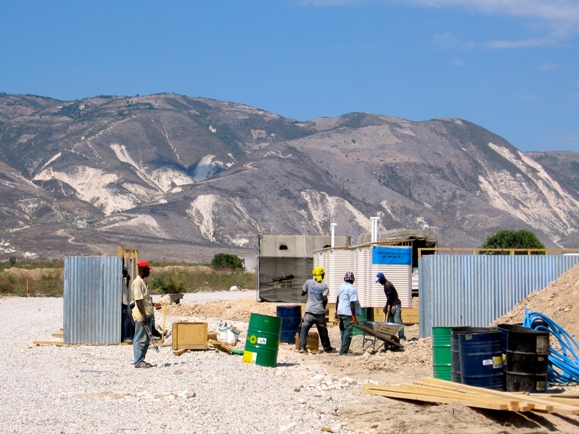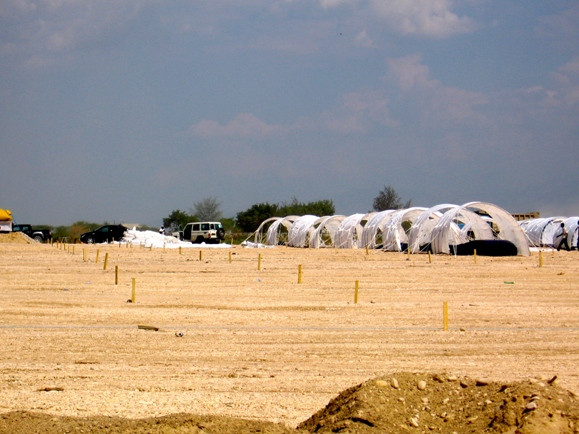See below a blog by newly-arrived spokeswoman of Oxfam in Haiti, Julie Schindall.
What an intense week!
About 10 days ago, we found out that the government of Haiti identified a site for temporary location of homeless people living in flood-prone settlements in Port-au-Prince. They took two months to identify the site and we had one week to prepare it.
It's a desert-like flat plain about 15 km outside of PaP. The dust is intense. We sent out emergency WASH (water, sanitation, hygiene) teams to install latrines, showers and water bladders. They were the only ones working on the site up until the last day before the arrival of the first group of IDPs (internally displaced people -- ie, people left homeless by the quake and living in settlements). Our engineers installing latrines had to wear face masks to protect against all the dust. The American military calls that site "peanut butter camp," because when it rains, the plain turns into a brown mud pit.
That's not to say the site can't be made workable.
Our engineers have experience in countries all around the world with tough climates, including Chad and Ethiopia. But it takes time to dig pits around 12 feet deep, lay in large stones and wooden frames to secure the loose soil, and drop in corrugated metal walls. Then the latrine is covered with one of our latrine slabs and around the slab goes a reinforced heavy plastic box with a raised, ventilated roof. The latrines also need handles and locks for the security of the person inside. Someone looking at our latrines at the site on Saturday asked if we could move them a little bit to be closer to his organization's temporary camp. I looked at him and said, "It's 12 feet into the ground. That's no Port-a-Potty."
Finally, just before the IDPs were due to arrive, gravel was laid down. Other agencies arrived with a mobile clinic and hygiene kits. Our water bladders were filled and we made sure enough showers were working for the first small group of people. (Thank goodness for that water bladder. It's the best water I've drunk my entire time in Haiti. It's slightly chlorinated taste reminds me of my childhood, where the city also slightly chlorinated the water.)
I went back out to the site on Saturday because I figured a lot of media would be there. I wanted our engineers to do their job and I would talk to the press. Everyone was in a nervous state all afternoon. Boys from the neighboring camp played soccer on the newly flattened fields. American soldiers lounged in their humvees. The IOM (International Organization for Migration) officer kept staring nervously at his watch.
Finally the rounded buses arrived with the new camp residents. The media followed. President Preval was traveling with the convoy too. They started filing out. A little boy walked through the dust mounds, each little hand small inside of the bigger hands of two women by his side. Someone next to me said the President was there, but I couldn't see him through the horde of media and soldiers and NGO workers.
I was sort of wandering around the registration tents, where the residents were getting information about their new place to live. I walked up to people with cameras and introduced myself. Wherever the President went, so went the cameras.
A little while later, CNN and al-Jazeera asked me to give an interview. The cameraman asked me to take off my sunglasses. When I did, I almost stumbled backwards as my eyes adjusted to the light. I'd been wearing them all day against the blinding sun. Thank goodness for wrap-around polarized sunglasses. They protect your eyes from the light and the dust.
Saturday was an intense day, but I was really proud of Oxfam. Earlier that week, we'd issued a press release with World Vision and CARE, protesting the last-minute way the site was picked, and the lack of planning and coordination. We worked long hours to get the site ready on time, and we are so proud of our engineers who toughed out those difficult conditions. At least we know that those people have clean water, a sanitary and safe toilets and showers.

